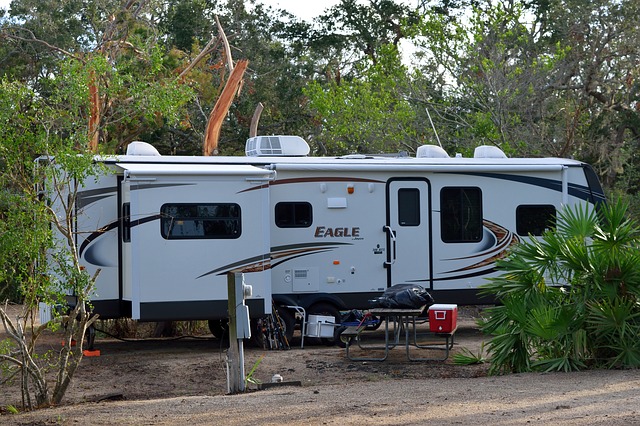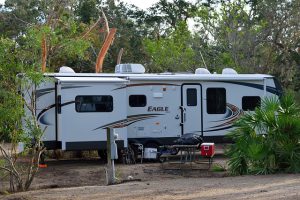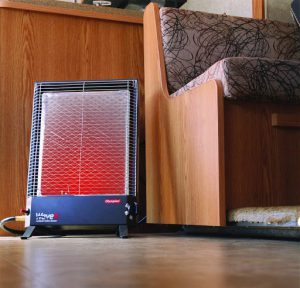
Your propane RV furnace is an important part of your new rig! You’re going to want to learn a little about it – how it works, how to care for it, and what to do when you need to use it. It’s going to mean the difference between chilly nights shivering in bed, and a warm, comfortable trip in your motorhome!

1. Be safe
Make sure you handle any problems with your heater safely. While propane is a clean and safe fuel to use, there is still a risk of injury if you’re not careful and don’t take proper precautions. Make sure you have a carbon monoxide detector installed in your RV. You can find an inexpensive one online, and easily fasten it to a ceiling or wall yourself. Check for leaks on a regular basis, and especially if your RV has been sitting unused for a while.
2. Know about furnace cycling
Your RV propane furnace will take 15-30 seconds to come on after you turn on your thermostat, and then run for another 15-30 seconds before you start feeling the heat. Once your RV has reached the temperature you set, the furnace will shut off, while the blower runs for a short time after. It will continue doing this to keep your temperature steady.
3. Know what your RV gas furnace smells like
You may notice a strong odor from your furnace when you turn it on – especially the first time you turn it on for the season (often this happens at home, too!). The smell should go away after the heater has been running for a while – it’s a combination of dust and other particles setting in the vents. Check to make sure your outside exhaust vent is clear before running your heater.
4. Good air flow
Make sure your air vents and floor ducts are clear to get maximum air flow throughout your motorhome. Check for mats, pet bowls, towels, or other obstructions that could be blocking vents – especially on the floor.
5. Know your shut-off valve
Propane furnaces for RV have a manual shut-off valve for the furnace. Make sure you know where it is and how to turn off your furnace manually, just in case. Also, if you can’t get your RV gas furnace to come on, be sure the shut-off valve is in the “on” position.
6. Know the propane smell
There is an additive in propane so you can smell it if there’s a leak (propane is naturally odorless, so the smell is added for safety reasons). If you smell it, or suspect a leak, shut off the gas supply at the tank and call to have it serviced.
7. Know about gas regulators
Your propane tank has a device to keep your gas pressure regulated as it’s going through the RV propane heater. Regulators can go bad after a while, and can’t be repaired. If you have a bad gas regulator, you’ll need to purchase a replacement. To check for a bad regulator, light all the stove burners and check the color of the flame. If it’s blue with a yellow tip, your regulator is working just fine. If it’s not blue, and there is very little or no yellow, your regulator may be going bad. Any adjustments to your regulator should be made by a professional RV service technician. Also, have your regulator tested and checked for leaks every year, and carry a spare with you. Also, your RV should have an LP regulator cover – make sure you use that to protect your equipment.

8. Different RV propane furnaces
There are a few highly rated propane furnaces for RV that you may want to look at when shopping for one.
- The Camco 57351 Olympian Wave-8 LP Gas Catalytic Heater is highly recommended. Reviewers like that it heats spaces quickly and quietly and has an automatic shut-off valve.
- The Suburban NT-30SP Electronic Ignition Ducted Furnace gets high marks for efficiency – it has an electronic ignition, which is more efficient than a conventional pilot light because it doesn’t always have to be on. It also heats a large motorhome easily. It is more expensive, but reviewers say it’s expected to last 30 years or more.
- The Suburban 2438ABK NT-16SEQ Furnace is praised for being almost inaudible (the “Q” actually stands for “quiet”). The small, vented heater works quickly in a space of up to 800 square feet and has an electric ignition.
- The Mr. Heater F274830 MH18BRV Big Buddy Portable RV Propane Heater is a highly-rated portable heater that quickly reaches spaces of up to 300 square feet. It can be used indoors or outdoors and is nearly 100% efficient.
Hopefully, this gives you some good ideas while shopping for RV propane furnaces – they’re an investment that will definitely improve the quality of your travels!
This post may contain affiliate links.
